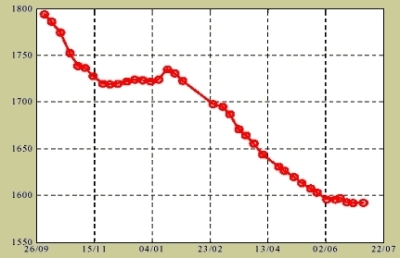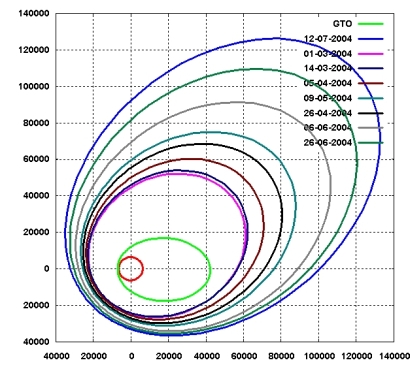No. 26 - The Cruise Phase Continues
The Electric Propulsion power is operating at 1358 W, as the power margins on the spacecraft are rather comfortable and operating at a higher power level saves fuel. The Earth has now passed the aphelion point of its orbit around the Sun. As indicated in the graph below there has been a steady decline in the power output of the solar array since perihelion in January.
 |
|
Degredation in Power Output from Solar Panels since Launch |
The electric propulsion thruster still exhibits some variation in thrust, caused by the varying amplitude of the anode current oscillation (see status report #25 for a more detailed explanation). No Optocoupler Single Event Transients, causing the flame-out, have been observed during this period.
Up to 3 July, and the 248th engine pulse, the ion-engine had cumulated a total ON time of about 2643 hr, consumed about 41.6 kg of Xenon and imparted to the spacecraft a velocity increment of about 1930 ms-1.
Systems Update
In status report #24, 11 June 2004, a slight degradation in performance of Transmitter A, as measured by on-board telemetry parameters, was indicated. In an initial attempt to understand the problem an experiment to measure the electromagnetic power radiated to ground by Transmitter A, compared to Transmitter B has now taken place. This required a special orbital configuration and careful procedures to be in place. The test confirmed that the Transmitter A is about 1 dB (1 W) weaker than Transmitter B. Experts are making further investigations.
Orbital/Trajectory information
The osculating orbital elements are periodically computed by the ESOC specialists. These elements define the so-called "osculating orbit" which would be travelled by the spacecraft if at that instant all perturbations, including EP thrust, would cease. So it is an image of the situation at that epoch. In reality the path travelled by the spacecraft is a continuous spiral leading from one orbit to another. The most recent osculating elements are as follows:
|
EPOCH (UTC) 2004/07/12 08:50:37.7 Elements WRT Earth (J2000) |
|
| Pericentre Distance (km) |
28 739.654808 |
| Apocentre Distance (km) |
161 511.243113 |
| Semi Major Axis (km) |
95 125.448961 |
| Eccentricity |
0.697876 |
| Inclination (deg) |
6.864896 |
| Asc. Node (deg) |
130.992152 |
| Arg. of Pericentre (deg) |
222.453041 |
| True Anomaly (deg) |
180.073651 |
| Osc. Orbital Period (h) |
81.106108 |
In this diagram the osculating orbits at launch (GTO) and at different times are plotted. The large effects that the operations of the electric propulsion now have on the orbit expansion is clearly visible. Especially the height of the apogee has dramatically increased and now exceeds one third of the Earth Moon distance.
 |
|
SMART-1 osculating orbit up to 12 July |
Since the start of the mission, the electric propulsion system has changed the orbital parameters as follows:
- The semi-major axis from 24 626 km to 95 125 km
- The perigee altitude from 656 km to 22 361 km
- The apogee altitude from 35 880 km to 155 133 km
- The orbital period from 10 hours 41 minutes to 3 days 9 hours
Contact Points
Giuseppe Racca
SMART-1 Project Manager
ESA/ESTEC - SCI-PD
Keplerlaan 1- 2200 AG Noordwijk, The Netherlands
E-mail: Giuseppe.Racca esa.int
esa.int
Bernard H. Foing
SMART-1 Project Scientist
ESA/ESTEC - SCI-SR
Keplerlaan 1- 2200 AG Noordwijk, The Netherlands
E-mail: Bernard.Foing esa.int
esa.int

